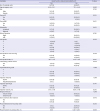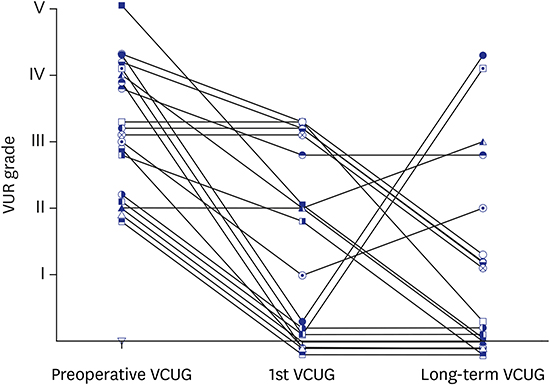1. Lebowitz RL. The detection and characterization of vesicoureteral reflux in the child. J Urol. 1992; 148(5 Pt 2):1640–1642.

2. Chand DH, Rhoades T, Poe SA, Kraus S, Strife CF. Incidence and severity of vesicoureteral reflux in children related to age, gender, race and diagnosis. J Urol. 2003; 170(4 Pt 2):1548–1550.

3. Tekgül S, Riedmiller H, Hoebeke P, Kočvara R, Nijman RJ, Radmayr C, et al. EAU guidelines on vesicoureteral reflux in children. Eur Urol. 2012; 62(3):534–542.

4. Stein R, Dogan HS, Hoebeke P, Kočvara R, Nijman RJ, Radmayr C, et al. Urinary tract infections in children: EAU/ESPU guidelines. Eur Urol. 2015; 67(3):546–558.

5. Diamond DA, Mattoo TK. Endoscopic treatment of primary vesicoureteral reflux. N Engl J Med. 2012; 366(13):1218–1226.

6. Matouschek E. New concept for the treatment of vesico-ureteral reflux. Endoscopic application of teflon. Arch Esp Urol. 1981; 34(5):385–388.
7. Elder JS, Diaz M, Caldamone AA, Cendron M, Greenfield S, Hurwitz R, et al. Endoscopic therapy for vesicoureteral reflux: a meta-analysis. I. Reflux resolution and urinary tract infection. J Urol. 2006; 175(2):716–722.

8. Routh JC, Inman BA, Reinberg Y. Dextranomer/hyaluronic acid for pediatric vesicoureteral reflux: systematic review. Pediatrics. 2010; 125(5):1010–1019.

9. Chertin B, Kocherov S, Chertin L, Natsheh A, Farkas A, Shenfeld OZ, et al. Endoscopic bulking materials for the treatment of vesicoureteral reflux: a review of our 20 years of experience and review of the literature. Adv Urol. 2011; 2011:309626.

10. Chertin B, Colhoun E, Velayudham M, Puri P. Endoscopic treatment of vesicoureteral reflux: 11 to 17 years of followup. J Urol. 2002; 167(3):1443–1445.

11. Chertin B, Puri P. Endoscopic management of vesicoureteral reflux: does it stand the test of time? Eur Urol. 2002; 42(6):598–606.

12. Kirsch AJ, Perez-Brayfield M, Smith EA, Scherz HC. The modified sting procedure to correct vesicoureteral reflux: improved results with submucosal implantation within the intramural ureter. J Urol. 2004; 171(6 Pt 1):2413–2416.

13. Lee EK, Gatti JM, Demarco RT, Murphy JP. Long-term followup of dextranomer/hyaluronic acid injection for vesicoureteral reflux: late failure warrants continued followup. J Urol. 2009; 181(4):1869–1874.

14. Holmdahl G, Brandström P, Läckgren G, Sillén U, Stokland E, Jodal U, et al. The Swedish reflux trial in children: II. Vesicoureteral reflux outcome. J Urol. 2010; 184(1):280–285.

15. O'Donnell B, Puri P. Treatment of vesicoureteric reflux by endoscopic injection of Teflon. Br Med J (Clin Res Ed). 1984; 289(6436):7–9.
16. Puri P, Ninan GK, Surana R. Subureteric Teflon injection (STING). Results of a European survey. Eur Urol. 1995; 27(1):71–75.
17. Glassberg KI, Laungani G, Wasnick RJ, Waterhouse K. Transverse ureteral advancement technique of ureteroneocystostomy (Cohen reimplant) and a modification for difficult cases (experience with 121 ureters). J Urol. 1985; 134(2):304–307.

18. Lavelle MT, Conlin MJ, Skoog SJ. Subureteral injection of Deflux for correction of reflux: analysis of factors predicting success. Urology. 2005; 65(3):564–567.

19. Yucel S, Gupta A, Snodgrass W. Multivariate analysis of factors predicting success with dextranomer/hyaluronic acid injection for vesicoureteral reflux. J Urol. 2007; 177(4):1505–1509.

20. Zamilpa I, Koyle MA, Grady RW, Joyner BD, Shnorhavorian M, Lendvay TS. Can we rely on the presence of dextranomer-hyaluronic acid copolymer mounds on ultrasound to predict vesicoureteral reflux resolution after injection therapy? J Urol. 2011; 185(6):Suppl. 2536–2541.

21. Läckgren G, Wåhlin N, Sköldenberg E, Stenberg A. Long-term followup of children treated with dextranomer/hyaluronic acid copolymer for vesicoureteral reflux. J Urol. 2001; 166(5):1887–1892.
22. Oswald J, Riccabona M, Lusuardi L, Bartsch G, Radmayr C. Prospective comparison and 1-year follow-up of a single endoscopic subureteral polydimethylsiloxane versus dextranomer/hyaluronic acid copolymer injection for treatment of vesicoureteral reflux in children. Urology. 2002; 60(5):894–897.

23. Nordenström J, Sjöström S, Sillén U, Sixt R, Brandström P. The Swedish infant high-grade reflux trial: UTI and renal damage. J Pediatr Urol. 2017; 13(2):146–154.

24. Hubert KC, Kokorowski PJ, Huang L, Prasad MM, Rosoklija I, Retik AB, et al. Durability of antireflux effect of ureteral reimplantation for primary vesicoureteral reflux: findings on long-term cystography. Urology. 2012; 79(3):675–679.

25. Schober MS, Jayanthi VR. Vesicoscopic ureteral reimplant: is there a role in the age of robotics? Urol Clin North Am. 2015; 42(1):53–59.
26. Boysen WR, Ellison JS, Kim C, Koh CJ, Noh P, Whittam B, et al. Multi-institutional review of outcomes and complications of robot-assisted laparoscopic extravesical ureteral reimplantation for treatment of primary vesicoureteral reflux in children. J Urol. 2017; 197(6):1555–1561.

27. McMann LP, Scherz HC, Kirsch AJ. Long-term preservation of dextranomer/hyaluronic acid copolymer implants after endoscopic treatment of vesicoureteral reflux in children: a sonographic volumetric analysis. J Urol. 2007; 177(1):316–320.










 PDF
PDF Citation
Citation Print
Print




 XML Download
XML Download